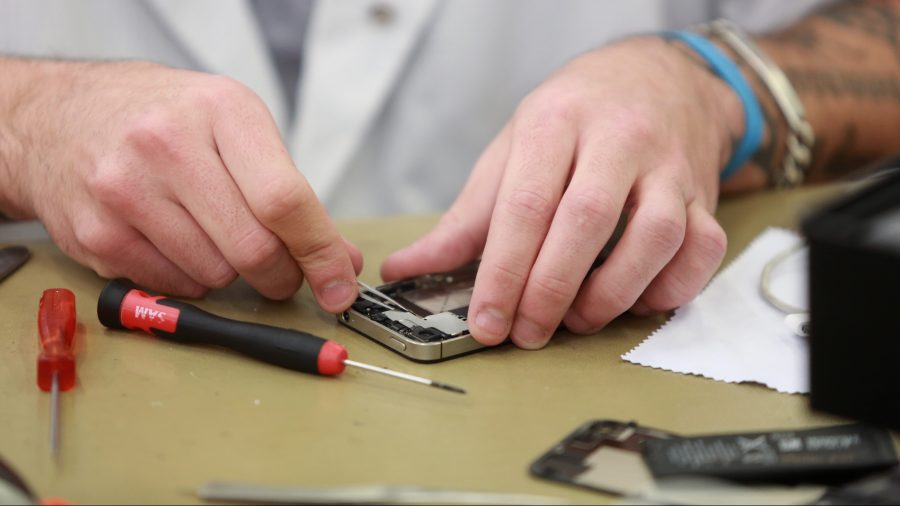Apple rolls out a DIY program to repair your iPhone

This week, Apple rolled out its Self Service Repair Store. Consumers and independent shops can now order spare parts and rent company-authorized tools to fix certain iPhones.
This comes after President Joe Biden issued an executive order in July promoting consumers’ “right to repair” their own electronics, and Congress is looking at it too.
That’s the topic for our recurring segment, “Quality Assurance,” where we take a second look at a big tech story.
Nathan Proctor directs the Right to Repair Campaign for the U.S. Public Interest Research Group. The following is an edited transcript of our conversation.
Nathan Proctor: Right now, just starting with a couple of repairs for the three newest iPhones, you can get all the materials needed that Apple would use in their authorized settings to do the repairs, and also an independent shop can order those. There are some restrictions there that are important. But this is the first time that they’ve been able to actually get those official Apple parts and tools.
Kimberly Adams: Let’s just say I want to use this new kit from Apple. How does this process work?
Proctor: It feels a little complex for even a committed DIYer. You have to order a specific part, which comes basically pre-coded to your phone. So you need to order it through this special process. They will also ship you, like, 70-plus pounds of tools in the mail that you rent to complete the repair. And then you have instructions, and you can walk through the repair. And I’m not sure how many individuals would do that. But I’m on a lot of message boards with repair shops around the country, given the campaign, and I know that repair shops all over the country have already put in orders because they have a set of phones that they need to fix.

Adams: How well does this actually, though, address the concerns of right to repair around these phones?
Proctor: Quite honestly, other companies just don’t have nearly as much in the way between you and your repair. Both Samsung and Google announced that they will partner with iFixit, which is kind of like the DIY headquarters on the internet, to sell spare parts direct to consumers along with official documentation and instructions and any special tools necessary. And there’s very little restriction on who can buy them and how they can do those repairs. I think that the most significant downside to the Apple system is this digital parts pairing that they do where the phone is paired to a specific part. And I think that that makes this program evidence that more could be done, but also evidence that more needs to be done.
Adams: Apple, Google and Samsung, they’re moving toward giving out information that was considered proprietary, and they’d been guarding this stuff pretty tightly. Why is this happening now?
Proctor: I mean, I think it’s a sign that the kind of collective action that’s been going on around the right to repair is breaking through, right? So over the last couple years, there’s been 27-plus states that have had legislation to empower consumers to have access to parts and tools and information to fix things. The Biden administration issued an executive order in July, which was followed shortly after with the Federal Trade Commission issuing new guidance against repair restrictions. And then both Google and Apple shareholders filed resolutions to push the companies to make these changes, so I think it’s coming from all sides.
Adams: Some individual states have passed their own right-to-repair laws, both the House and Senate have introduced legislation. As you mentioned, there’s a regulatory push. What are you watching for next, in terms of federal action on right to repair?
Proctor: We’re really hopeful that the FTC can start taking public action to make it really clear that certain kinds of basically, monopolistic repair restrictions are not going to be permitted under current law. And I’m really excited about the opportunity to see some of that enforcement come to big companies like Apple, and, you know, potentially other dominant manufacturers and other industries, whether they be medical technology or farm equipment at John Deere. I think that there’s a lot of opportunity for the FTC to force these companies to open up their repair markets.
Adams: Why is this the moment for right to repair?
Proctor: I think so many people have had this experience where they take a broken device to the Apple store, to the official manufacturer’s repair person, and they’re told, “No, it’s impossible to fix. Here, let me show you the newest models.” Meanwhile, electronic waste is the fastest growing part of our waste stream. And it’s really expensive to keep buying new stuff all the time, especially when you know the supply chain is facing all kinds of significant barriers and the economy is tightening up. People need to make best use of what they already have, and companies need to stop blocking us from fixing what we already own.
We asked Apple to comment on criticism that its phone repair system is impractical. An Apple spokesperson referred us to the company’s online explanation of the service and repair program and added that there is no requirement that consumers rely on Apple tools if they “prefer an alternative.”
Related Links: More insight from Kimberly Adams
If you want to read more about the program, Apple has a frequently asked questions page that features more details on what’s in those 70-pound tool kits.
And if you’re wondering, like me, how cost effective this is, The Verge has a story breaking down some of the costs of DIY repairs, which it says probably aren’t much cheaper than having Apple fix it.
Incentives, right?
Lastly, if you want to hear more about right to repair, we have some episodes we’ve released over the last year, including the complications of fixing something bigger — say your John Deere tractors. And one on the laws on right-to-repair making their way through state legislatures.
The future of this podcast starts with you.
Every day, the “Marketplace Tech” team demystifies the digital economy with stories that explore more than just Big Tech. We’re committed to covering topics that matter to you and the world around us, diving deep into how technology intersects with climate change, inequity, and disinformation.
As part of a nonprofit newsroom, we’re counting on listeners like you to keep this public service paywall-free and available to all.
Support “Marketplace Tech” in any amount today and become a partner in our mission.












